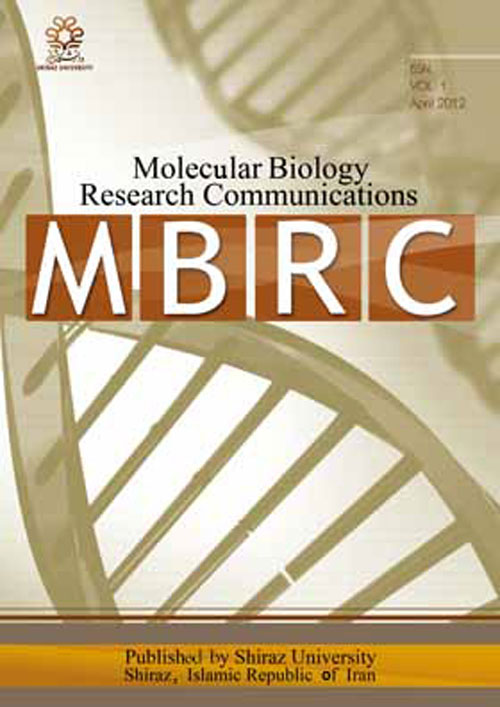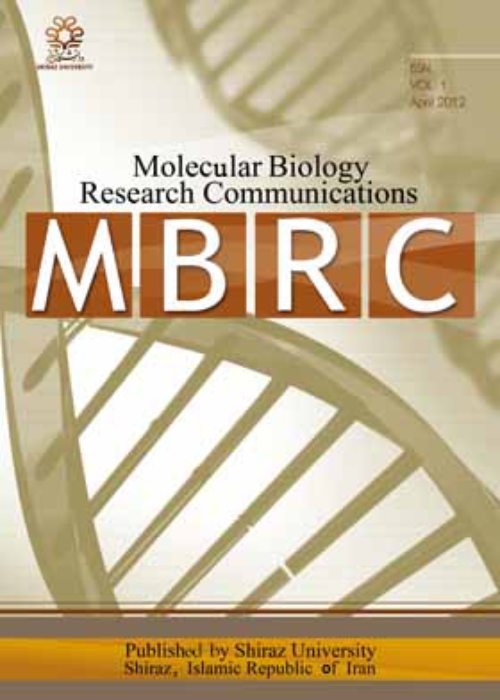فهرست مطالب

Molecular Biology Research Communications
Volume:7 Issue: 2, Jun 2018
- تاریخ انتشار: 1397/04/24
- تعداد عناوین: 6
-
-
Pages 51-58Genetically, every individual is unique; this may stem from inheritance, geographical locations, and/or environmental interactions. This study examined the possibility of developing a cheap and easy-to-use marker that can distinguish among the three ethnic groups in Nigeria using RAPD-PCR. Five RAPD primers, OPA1-3 and OPC1-2, were randomly selected and used to amplify DNA samples isolated from blood of eighteen human subjects representing the three major ethnic groups in Nigeria (six subjects each). Genomic DNAs were extracted using DNA isolation kit, RAPD-PCR amplification was performed and gel electrophoresis was done. Genetic similarity between the band polymorphism was evaluated as frequencies of occurrence and the phylogenetic tree constructed. Three of the five primers show various polymorphisms; the highest frequency band for primer OPA1 is 50% while that of primer OPA2 is 100% and for OPC2 is 83.33%. Although OPA2 has common bands in majority of the samples few of the bands are ethnic group specific. Bands 471 and 435 bp are specific for the Hausa ethnic group at 66.67% frequency. Similarly, in primer OPC2, band 320 can be used to distinguish the Hausas from the other two ethnic groups. Analysis of variance (ANOVA) and test for homogeneity showed that there is no significant difference in the polymorphism between and among the groups. In conclusion this research has given an insight into the possibility of developing RAPD primers that could be used to distinguish people of different ethnic groups.Keywords: Nigerian ethnic, RAPD, PCR, Genetic Variation, PyElph, Phylogeny
-
Pages 59-65Coronary artery disease (CAD) is a common health problem in Iranian population. ATP binding cassette transporter A1 (ABCA1) plays central role in the efflux of the cholesterol from peripheral tissues back to liver. Inactivation of ABCA1 by epigenetic change such as DNA methylation may contribute to the development of CAD. The present study investigated the association between promoter DNA methylation status of ABCA1 with the development and severity of CAD. Our study population consisted of 110 angiographically documented CAD patients and 110 controls. The severity of CAD was determined based on the number of stenotic vessels showing more than 50% stenosis. Promoter DNA methylation status of ABCA1 was determined by methylation specific PCR. Lipid profile was determined by routine colorimetric methods. Results showed that the frequency of ABCA1 DNA methylation was significantly higher in CAD group as compared with control group (16.36% vs 5.45%; P=0.015). Also, the methylation frequency of ABCA1 gene was significantly higher in older CAD patients as compared with younger CAD patients (P=0.038). No association was seen between plasma lipid concentration and the promoter DNA methylation status of ABCA1 (P>0.05). Also, the association between the severity of CAD and methylation of ABCA1 gene was not significant (P>0.05). In conclusion the current study indicated ABCA1 DNA methylation as a significant risk factor for development but not severity of CAD. Also, predisposition to the development of CAD by ABCA1 gene DNA methylation was independent of plasma lipid concentration.Keywords: Coronary artery disease, Methylation, ATP binding cassette transporter A1
-
Pages 67-76Interleukin-4 (IL-4) is a multifunctional cytokine that plays a critical role in apoptosis, differentiation and proliferation. The intensity of IL4 response depends upon binding to its receptor, IL-4R. The therapeutic efficiency of interleukins can be increased by generating structural mutants having greater stability. In the present work, attempts were made to increase the stability of human IL-4 using in-silico site directed mutagenesis. Different orthologous sequences of IL4 from Pan troglodytes, Aotusnigriceps, Macacamulatta, Papiohamadryas, Chlorocebusaethiops, Vicugnapacos, Susscrofa and Homo sapiens were aligned using Clustal Omega that revealed the conserved and non-conserved positions. For each non-conserved position, possible favorable and stabilizing mutations were found using CUPSAT with predicted ΔΔG (kcal/mol). The one with highest ΔΔG (kcal/mol) among all possible mutations, for each non-conserved position was selected and introduced manually in human IL-4 sequence resulting in multiple mutants of IL-4. Mutant proteins were modeled using structure of IL4 (PDB ID: 2B8U) as a template by SWISS MODEL. The mutants A49L and Q106T were identified to have stability centre using SCide. Molecular dynamics and docking analysis also confirmed the mutants stability and binding respectively. Mutants A49L and Q106T had -7.580079 kcal/mol and -39.418124 kcal/mol respectively lesser energy value than the wild type IL4. The result suggested that, the stability of human IL-4 has been increased by mutation.Keywords: IL, 4, stability centre, mutagenesis, cytokine, bioinformatics
-
Pages 77-82Dengue is a vector-borne disease caused by dengue virus. According to the recent report of CDC that one-third population of the world are at high risk with Dengue fever. The prevalence of the dengue hemorrhagic fever was found more in tropical and sub-tropical regions of the world. Aedes mosquitoes was reported as the main cause of transmission of dengue virus. So the current study was planned to characterize the virus in Aedes mosquitoes collected from different area of Pakistan. In current investigation, Aedes mosquitoes and larvae were trapped under conducive conditions which are counted as 495 Aedes mosquitoes and 260 Aedes larvae. First of all, adult mosquitoes were identified morphologically under microscopy, counted as 73.3% Ae. aegypti and 26.7% Ae. albopictus. Finally, reverse transcriptase polymerase chain reaction analyses that only 4 adults of Aedes mosquitoes and 10 Aedes larvae as naturally infected with dengue virus with possible source Ae. aegypti. This study basically uncovered the presence of virus in different species of mosquitoes in southern regions of Pakistan. The present study will also give us an insight for vector control programs of dengue virus in the affected area.Keywords: Dengue Virus, Aedes mosquitoes, Khyber Pakhtunkhwa Pakistan
-
Pages 83-88Heavy metals pollution is one of the key environmental problems. In this research, the effect of seed priming with salicylic acid and sodium hydrosulfide was investigated on methionine and arginine amino acids contents and some compounds derived from their metabolism as well as ZmACS6 and ZmSAMD transcripts levels in maize plants under lead stress. For this purpose, maize seeds were soaked in salicylic acid (0.5 mM) and sodium hydrosulfide (0.5mM) for 12 hours and then exposed to lead (2.5 mM) for 9 days. The results showed that lead stress reduced nitric oxide content and shoot ZmACS6 and ZmSAMD transcript levels while increased glycine betaine, methionine, arginine and proline amino acids contents as well as root ZmACS6 and ZmSAMD transcript levels. Salicylic acid and sodium hydrosulfide pretreatments reduced methionine, arginine and proline accumulation and increased glycine betaine and nitric oxide contents and regulated the expression of ZmACS6 and ZmSAMD genes (genes participating in methionine metabolism) under lead stress. Our data suggest that salicylic acid and hydrogen sulfide play role in regulating the methionine and arginine metabolism in maize under lead stress condition.Keywords: Amino acids metabolism, Hydrogen sulfide, Pb stress, Salicylic acid, Zea mays L
-
Pages 89-96Recent advances in molecular medicine have proposed new therapeutic strategies for cancer. One of the molecular research lines for the diagnosis and treatment of cancer is the use of long non-coding RNAs (LncRNAs) which are a class of non-coding RNA molecules longer than 200 base pairs in length that act as the key regulator of gene expression. Different aspects of cellular activities like cell growth, proliferation, differentiation, apoptosis and migration are regulated by lncRNAs. In various cancers, aberrant expression of lncRNAs has been reported. One of the lncRNAs that showed upregulation in human acute myeloid leukemia (AML) is lncRNA plasmacytoma variant translocation 1 (PVT1). Here, we performed blockage of lncRNA PVT1 in human acute erythroleukemia (AEL) cell line (KG1) using antisense LNA GapmeRs. Then, at different time points (24, 48 and 72 hours) after transfection, qRT‑real‑time PCR and Annexin‑V/Propidium Iodide staining assay were performed. The data were processed using the ANOVA test. At all three time points, the ratio of apoptotic cells in the PVT1 antisense LNA GapmeRs treated group was higher than the other groups. The ratio of necrotic cells in the antisense LNA GapmeRs group was also higher than the other groups. These assessments show that inhibition of lncRNA PVT1 could significantly induce apoptosis and necrosis in KG1 cells. Our findings can be used in translational medicine for future investigation in acute erythroleukemia and treatment approach based on antisense therapy.Keywords: Long non, coding RNA, LncRNA PVT1, Apoptosis, Acute erythroleukemia


